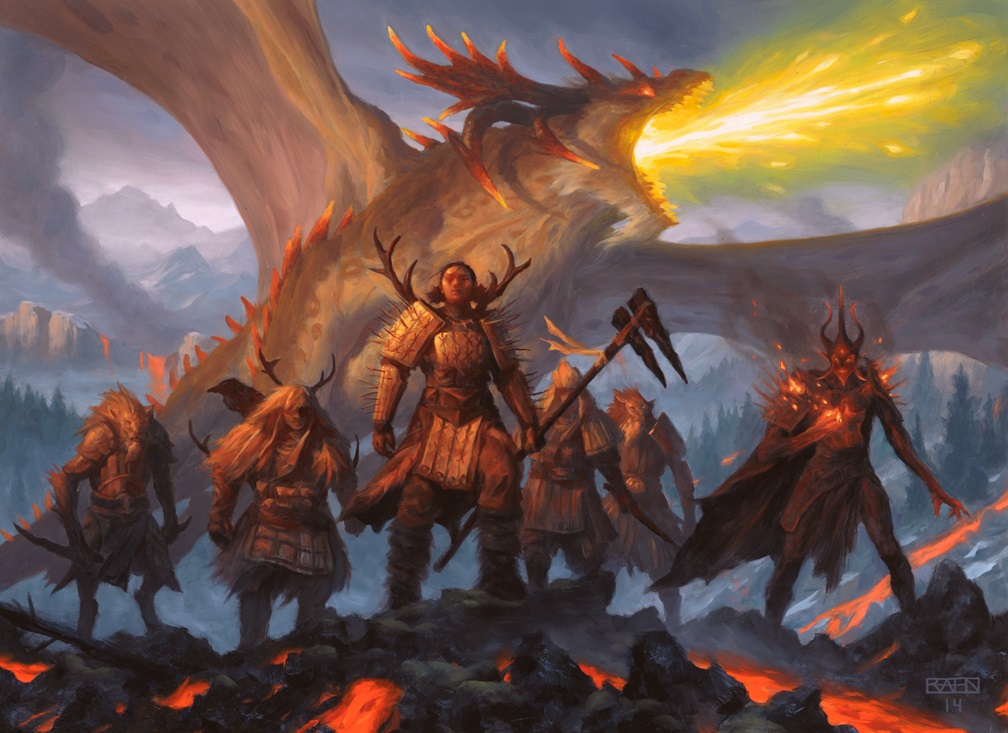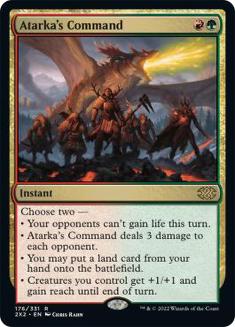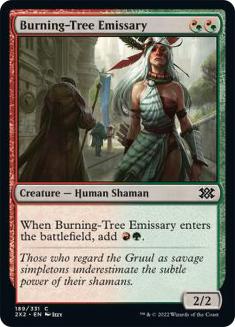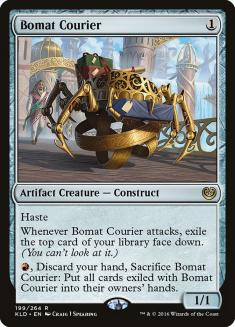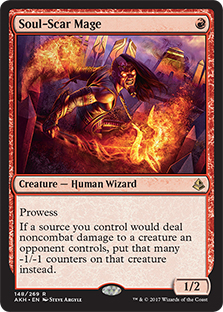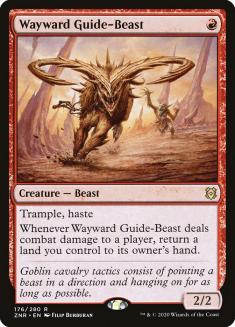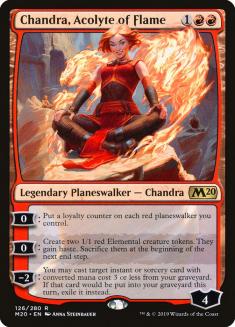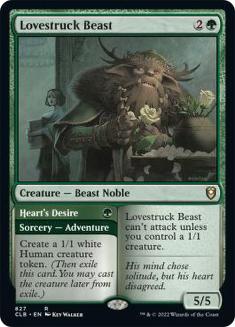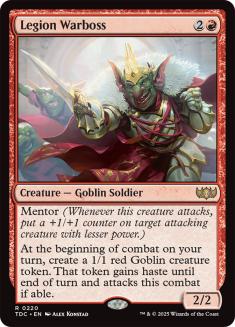Historic Anthology V has been completely unveiled, revealing another batch of new cards for Magic’s most unpredictable format. I’m not entirely sure what the goals for these mini-additions are, but it’s certainly a good way to keep us players on our toes when it comes to building new archetypes so the metagame doesn’t fall into a rut before it becomes fully explored.
The latest Anthology has several cards that should find homes in Historic. The one I want to focus on has quite a bit of pedigree: Atarka’s Command.
Atarka Red was a premier archetype during Atarka’s Command’s time in Standard. We’ve seen Burn variants in Modern splash green for the card as well. For those who aren’t as familiar with the card’s history, here’s a quick rundown.
We’re looking to maximize the second and fourth modes. For any aggressive deck, choosing those two represents five or more damage rather easily, letting Atarka’s Command outpace Boros Charm.
The first mode offers some versatility against lifegain effects, which any aggressive deck appreciates, especially when it comes stapled onto an effect you’d already like to play. Oftentimes spending a full card to stop opposing lifegain with something like Leyline of Punishment ends up being worse than playing more burn spells, since they have to draw the lifegain for your card to have any impact, and additional copies are useless. Having an anti-lifegain effect on a burn or pump spell drastically reduces its opportunity cost, making it much more valuable.
The third mode is essentially blank text, but every so often you’ll use it as a way to double-spell when you otherwise couldn’t, so keep it in mind. The best part is when it does come up, it always takes your opponent by complete surprise.
Atarka’s Command is a powerful card for most aggressive decks because of its ability to force through damage at an excellent rate and make combat difficult. It’s hard to block against an opponent with two mana available that could potentially pump their entire team, so oftentimes the threat of Atarka’s Command will force through damage even when you haven’t drawn it. As for its potential in Historic, I’m optimistic in large part due to its synergy with Burning-Tree Emissary.
This innocuous Grizzly Bears is one of the most powerful cards in Gruul Aggro. It plays incredibly well with Atarka’s Command, which wants to see a wide battlefield of creatures to maximize the damage output from the pump mode. With free creatures on Turn 2, you’re setting up to have an incredibly explosive Turn 3 that could end the game on the spot and will at least put your opponent in a precarious position where they are forced to defend their life total at all costs.
Traditional Gruul Aggro Isn’t a Good Fit
Despite obvious synergy with Burning-Tree Emissary, I don’t think typical Historic Gruul Aggro is a good fit for Atarka’s Command.
Creatures (33)
- 4 Llanowar Elves
- 3 Scavenging Ooze
- 4 Burning-Tree Emissary
- 4 Voltaic Brawler
- 1 Hazoret the Fervent
- 4 Pelt Collector
- 4 Gruul Spellbreaker
- 3 Questing Beast
- 4 Bonecrusher Giant
- 2 Klothys, God of Destiny
Lands (22)
Spells (5)

That’s because, as it’s currently built, it’s trying to go tall rather than go wide. Burning-Tree Emissary makes the cut because it’s simply too powerful to ignore, but the rest of the creature base consists of individually powerful, large creatures along with one-drops that maximize those creatures. Llanowar Elves lets you land your Lovestruck Beasts and Gruul Spellbreakers ahead of schedule, while Pelt Collector loves to brawl alongside larger creatures so it can get larger as the game progresses.
But Atarka’s Command is a much worse finisher in such a deck than the Embercleaves they already play. Atarka’s Command fits into a deck with a significantly lower curve since it’s a great source of reach for decks with smaller creatures that eventually become invalidated as the game progresses.
Aggro decks that are looking to go wide tend to play better against decks focusing on cheap spot removal, since they often flood the battlefield too quickly for such removal to keep up. They are weaker against sweepers and big creatures since you need to commit more resources to the battlefield to create a sufficient clock and aren’t big enough to rumble in combat with the Lovestruck Beasts of the world.
Keeping these weaknesses in mind, here are my ideas for how to maximize Atarka’s Command in Historic.
Atarka Red
Let’s start with the basics:
Creatures (25)
- 4 Burning-Tree Emissary
- 4 Bomat Courier
- 4 Soul-Scar Mage
- 4 Ghitu Lavarunner
- 4 Viashino Pyromancer
- 4 Bonecrusher Giant
- 1 Wayward Guide-Beast
Planeswalkers (2)
Lands (21)
Spells (12)

This list is a spiritual successor of the Atarka Red decks that existed in Standard years ago. Green is a light splash just for Atarka’s Command to keep the mana as consistent as possible. The curve is as low as possible, ending at three in the maindeck and four in the sideboard.
The key to figuring out this list lay in deciding which one-drops to play. Bomat Courier is the only auto-include in my opinion, because it’s important to have cards you can cast off the green mana generated by Burning-Tree Emissary’s triggered ability. Of course all of the two-drops are chosen to be castable with that mana, but it’s nice to open yourself up to the nut draw of casting multiple spells with it instead.
Past Bomat Courier, Soul-Scar Mage is the most powerful option. This deck doesn’t have a ton of spells, but it’s enough to make it larger than the other options on average, and the static ability lets you effectively neutralize larger creatures with your burn spells. I value that quite highly given how popular creatures like Lovestruck Beast are in the current metagame, so Soul-Scar Mage got the nod.
Once I was playing Soul-Scar Mage, it made sense to commit to the Wizard package often seen in Pioneer Burn. Ghitu Lavarunner would play well with the burn spells and token makers I wanted in the deck in the first place, and Viashino Pyromancer is a solid creature that fits the criterion of being castable with Burning-Tree Emissary mana.
From there the deck filled out rather quickly. Wizard’s Lightning is the payoff for putting Wizards into your deck. Forbidden Friendship is a marginally better token producer than Goblin Instigator or Dragon Fodder by virtue of being a sorcery and sometimes offering an extra damage via haste. Bonecrusher Giant is an awkward fit thematically but it’s too powerful to leave out, and you want plenty of burn to close the game out.
With the remaining spots I decided on a single copy of Wayward Guide-Beast and two copies of Chandra, Acolyte of Flame. Guide-Beast is there as a commitment to the deck’s low curve. It’s a great Turn 3 play alongside an Atarka’s Command, can help you double-spell if you don’t have another land drop, and continues to fill the deck with reach. It’s obviously bad early and bad in multiples, but the first copy is quite valuable, even if I sideboard it out frequently.
The Chandras work well with the various spells in the deck. You can flashback a threat to rebuild your battlefield in Forbidden Friendship or extra burn to close the game out. It’s also a great way to press an early advantage without overextending into a sweeper. I love having threats like that in a go-wide strategy since it takes away the tough decisions of guessing whether they have a sweeper and how much you can afford to play around it. I always look to take the difficult decisions out of my hands and put them onto my opponent.
In the aggregate, this deck has 34 cards that offer the potential for immediate damage between haste creatures, burn spells, and Ramunap Ruins. You can afford to go all-in early to get your opponent into burn range and trust in topdecks. Normally decks with that much reach don’t have as many threats, but this list has 31 cards that produce creatures. So there’s a great balance struck here between being an aggro deck and a burn deck. It’s in finding that balance where Atarka’s Command is at its best.
Atarka Gruul
The second build I have is more green-focused, but differs significantly from the Gruul decks being played currently.
Creatures (28)
- 4 Llanowar Elves
- 4 Burning-Tree Emissary
- 4 Bomat Courier
- 4 Legion Warboss
- 4 Lovestruck Beast
- 4 Robber of the Rich
- 4 Jaspera Sentinel
Lands (20)
Spells (12)

While Pelt Collector didn’t make the cut because there aren’t enough large creatures to effectively pump it, I’m leaning even further into the mana acceleration by supplementing Llanowar Elves with Jaspera Sentinel. I particularly like how Sentinel can combine with Burning-Tree Emissary to cast a three-mana creature on Turn 2, so I’ve included both Lovestruck Beast and Legion Warboss to take full advantage of that curve.
Those two threats allow you to go wide by creating multiple bodies, but they’re also great standalone threats. This list straddles the line between go-wide and go-tall. The lone four-drop in the deck, Esika’s Chariot, also blurs the line between the two, and plays nicely with the other token generators in the deck.
The hardest decision in this deck was which other two-drop to play alongside Forbidden Friendship and Burning-Tree Emissary. I went with Robber of the Rich since it’s a powerful haste creature and this list has much less haste than the base-red list. But there are plenty of other options for this slot, from Scavenging Ooze to Gallia of the Endless Dance. I’d encourage you to play around with those and other choices.
With much less in the way of removal, I made sure to include Shatterskull Smashing in the manabase, which also functions as a nice mana sink when you flood on Llanowar Elves and Jaspera Sentinels. With those in the deck and a higher need for Rootbound Crags, I didn’t feel comfortable playing other utility lands like Ramunap Ruins and Castle Embereth. As much as I like utility lands, the most important task of your manabase is to consistently cast your spells on time (especially in an aggro deck).
With how successful small aggro decks have been in Pioneer, it’s strange to see how much they have struggled in Historic. But Atarka’s Command is a major upgrade to those archetypes and I’m excited to see what it can do in the format. And I guess it wouldn’t be an option to add to the format via a reprint unless Wizards of the Coast (WotC) wanted to print another Tarkir set or functionally reprint it under another name. These Anthologies and other small sets are a great way for WotC to make small changes to Historic without upsetting the current metagame too much.
Now if we can just get Manamorphose to complete my Izzet Phoenix dream, I’ll be all set!

